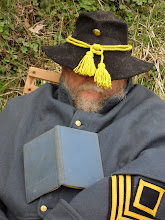"Alright. Company forward rant!"
I'm reading along, it's getting good, the writer's stuff is really flowing beautifully, the hero checks the clip in his revolver and--THUD!...Jesus, Mary, and Joseph! Don't these people do ANY research?
For some reason known only to the All Mighty, there are a large number of writers out there in the outer darkness who apparently believe they can wing it when it comes to firearms. Rather than burn fifteen minutes online, they make fools of themselves. They will obsess about which train enters which station at a particular hour on Tuesdays and Fridays. They will have nine or ten books piled on their reference table covering the bloodlines of Yorkies. They will have maps of every town that they mention from Roman times to the present in New South Wales. But they will not Google or Yahoo search the word "revolver."
If these folks took the same care while writing about other things, their protagonist would walk out of her yurt, climb up on the fender of the Jugo, slide the canopy back, stick the hand crank in the instrument panel, and with brisk turn fire up its rocket motor.
Why is this? One friend is of the opinion that such writers are afraid of guns and can't bring themselves to think about these devices of the devil. Another postulates that they watch shows on TV and figure that teaches all they need to know (no doubt they also pick up tips on interpersonal relationships from the same shows). I'm told that my contention that they are feeble-minded or bone lazy is too harsh.
Just for my own piece of mind and to, hopefully, keep my blood pressure in check while reading in the future, I will be posting tips from time to time for the firearm-challenged in keyboard land.
Lesson 1: Revolvers
Revolvers do not have either "clips" or magazines. What they have are cylinders. The cartridges (not "bullets" or "shells") are loaded into the cylinder. Each time the hammer (the little lever sticking out the back above your hand) is cocked [single action] or the trigger is pulled [double action] the cylinder revolves (get it?) bringing a unfired round into line with the barrel and firing mechanism.
A cartridge, often called a "round," is composed of a bullet, a propelling charge (either black powder [old] or smokeless powder [modern]), and a cartridge casing (or shell casing). A primer in the base of the cartridge case is stuck by the firearm's firing pin and the propelling charge is set off causing the bullet to travel through the barrel and, after exiting said barrel, hopefully putting a hole in the designated bad guy.
Keep these rules in mind: A magazine holds cartridges. It can be internal (always part of the firearm) or it can be detachable (fits in a well on the firearm). A clip also holds cartridges and is usually pushed into a firearm's internal magazine and is either pulled out by the shooter or is kicked out when the last round is ejected.
Silencers and Revolvers:
You're watching a movie or show and you see the highly paid international assassin pull out a silencer and attach it to his revolver--CUT! Silencers (more properly called suppressors) don't work with revolvers. There is a gap between the front face of the cylinder and the rear end of the barrel. This gap will let the noise out when the revolver is fired even if equipped with a "silencer." For a suppressor to work properly, the action or mechanism must be closed when the cartridge is fired. There are such weapons as suppressed machine pistols. If the suppressor is new, one will hear little sound of the shot but there will be a noticeable chatter of the action operating as it ejects the fired cartridge casings. The whole point of a suppressor is not so much to silence the shot, but to make it sound like something other than a shot.
As a note, during the Vietnam War, two weapons that were nearly silent were issued to U.S. forces.
One was, indeed, a revolver made for the use of tunnel rats. The guys going down in VC holes had a problem with using the U.S. military's standard semi-automatic (fires one round each time the trigger is pulled) .45 caliber M1911A1 pistol. Fire one time in the dark and enclosed places and, between the noise and muzzle flash, you hear and see nothing for a while--not a good feeling. A revolver design was chosen because it is inherently more reliable and idiot-proof than a semi-automatic. The revolver that was issued on a limited basis was made so the cartridge casing actually sealed against the end of the barrel. No muzzle flash and little noise.
The other was a suppressed .22 caliber pistol called a "hush-puppy" issued to the SEALs for neutralizing guard dogs and sentries (DoD sometimes displays a fetish for non-loaded terms like "neutralizing"--as in "We neutralized the guy with three 30 millimeter rounds; then graves registration showed up to take care of the body with a sponge.").
There now, I feel much better. That should hold me until the next time.
19 January 2010: Feast of St. Wulfstan of Worcester, Henry V captures Rouen 1419, San Agustin Church completed in Manila 1607, Capt. Charles Wilks USN circumnavigates Antarctica 1840, Prussians defeat French in Battle of St. Quentin 1871.
Subscribe to:
Post Comments (Atom)




No comments:
Post a Comment